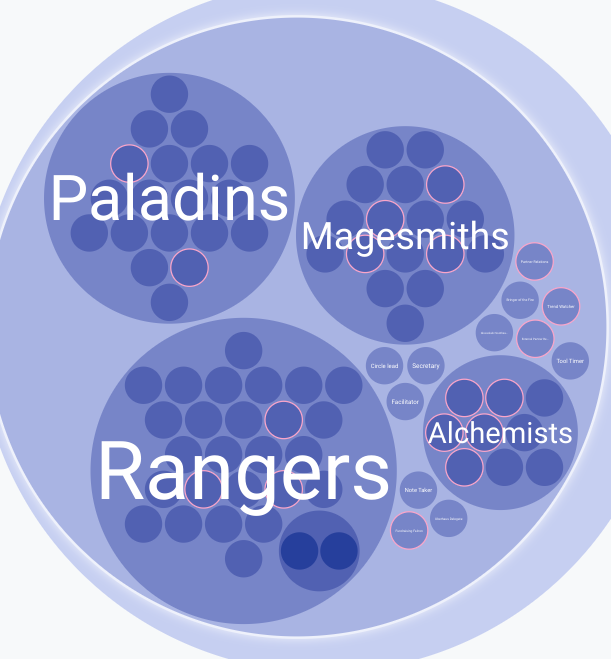more Rage Jelly where I barf out random thoughts on DAOs into the world
Thoughts on account abstraction, self management, and onchain DAOs building on the last Rage Jelly
tldr This idea uses Account abstraction (ERC6551) to architect an organization with some loose structure, taking advantage of decetralization tech, buttom up emergance, and keeping autonomy for the individual.
Instead of a DAO being composed of individual accounts which hold some voting power the DAO can use NFTs and 6551 to architect a structure of roles. The individual “souls” that occupy that role can be managed by individual agency.
Some Context
DAOs are a great way for a group of people to freely assemble around a shared purpose. When done right people from around the world can easily contribute, build a shared treasury and have direct and democratic decision making and execution rights to accomplish a goal… trustlessly. And one of the best parts, you don’t have to be a lawyer or computer science expert to do it and you don’t have to spend thousands of dollars (DAOhaus is a good place to start).
This checks off a few major hurdles in purpose driven organizations (capital formation and fair decision making) but it leaves the flexibility to act as the DAO sees fit. For example, DAOs can delegate action to a hierarchy, a benevolent dictator, delegated sub groups, or just be completely flat relying on the initiative of individuals. This lack of formally defined structure is a super power and a curse.
In the DAO nerd space the article "The Tyranny of Structurelessness'' is passed around a lot. It refers to the potential negative consequences that can arise when a group lacks formal structures or explicit power hierarchies. Basically, when there is no formal structure there are, sometimes worse, hidden informal structures. This essay was written 50 years ago and even though we have much better tools to foster more transparency and communication (and trustlessness), The Tyranny of Structurelessness is still major reason why DAOs can go from 0 to 1 but revert back to centralized control when trying to go from 1 to 100.
Its worth exploring alternate ideas on DAOs structure.
Ok so enough context, like duh, whatever, get to the point.
ERC6551 Token Bound Accounts (TBAs)
In this standard every NFT has its own account tied to it. That means that a NFT can own tokens (voting shares in a DAO), have roles in smart contracts or even hold other NFTs. The owner of the NFT can use this “bound account” just like they would use their own account. Although because this account is a smart contract, other powers, controls, guards and/or restrictions can be enabled.
Occupy Role st. (permissionless emergence)
To support individual agency and collective emergence any token holding DAO member can create and choose to occupy a role NFT. The NFT would actually be a SBT (Soul Bound Token, which means transfer is restricted from the owner with some control by the collective). This permissionless emergence also has a couple of other advantages
-
a role can take on other responsibilities (admin contracts, own sub roles), manage funds (through daily limits or streams), or even be an autonomous agent it’s self.
-
Along with the ability for a member to self appoint to an open role the DAO could appoint a member or remove one if needed.
-
Adoption of the role by relationships with other roles and relationships with the DAO make it more valid in the org. potentially a role has some actual voting power
Building the Organization Chart
Maybe the biggest advantage is that this keeps “snapshots” of the organization through time, allowing for better transparency and organizational intelligence. The provenance of occupation.

Circles
“Roles not Souls” comes from Holocracy which has similarities to this approach. One of the elements of holocracy is the idea of circles. Circles are really just roles with sub roles. Technically this can be accomplished by nested TBAs or the NFT being owned by another sub DAO or being a DAO itself. A TBA could be a DAO because MolochV3 is built on top of the Zodiac standard, so we could easily swap out a Safe for a TBA. A role may even have it’s own voting in the circle and ragequit (exit rights)
Escalation
Circles and Roles need to have the agency to be productive. This means everything they do should not have to go to a DAO wide consensus vote. Funding roles should be as automated as possible either through vesting streams or daily limits initially. Some times there may be friction and disagreements between roles and outlining structures. Friction is good and important, it means people care, but again resolutions should start local and only escalate to DAO consensus as the last resort.
Capitol contributions vs executors
for this we can leverage the 2 token system of MolochV3. Loot holders remain individual accounts (not roles but maybe they are all in a circle), retain their ability to a fair exit but do not have direct voting and execution (still ragequit is the most powerful form of governance). Roles are the only share holders, are the only ones with voting and execution rights

Conclusion: just some random thoughts, let me know what you think
Subscribe to me for more projectile hot takes and randomness
inspo
UI369 the resident holocracy expert. excellent article
TokenBound.org team spearheading the ERC6551 standard
critiques of holocracy by TW
Garage SPACE discord where they are hacking on a MUD Game around alternative org structure
tweet by cupofjoseph